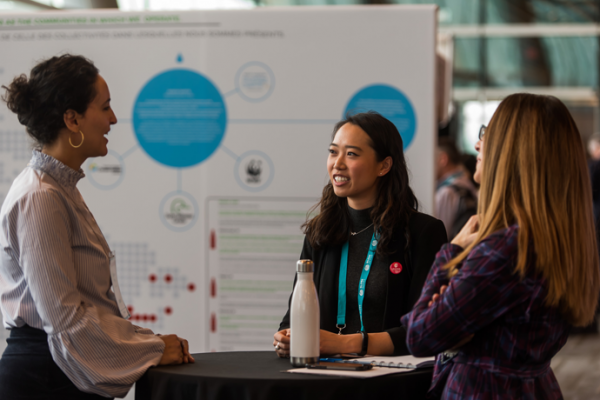By Phil De Luna, Green Party of Canada Candidate for Toronto-St. Paul’s
I have spent my entire career developing technologies to help decarbonize Canada. It started with my PhD in Materials Science & Engineering at the University of Toronto, where I discovered new renewable ways to convert carbon dioxide into fuels and chemicals. From there I co-founded a venture, Team CERT, to scale that clean technology out of the lab and became a finalist in the Carbon XPRIZE. I joined the National Research Council of Canada as its youngest-ever Director where I built and led a $57M collaborative R&D program to develop made-in-Canada technologies for decarbonization. Along the way, I have studied, discovered, developed, funded, mentored, and advocated for the development and expansion of cleantech.
At some point on this journey, I had a realization – technology alone is not enough to get us to net-zero. You can have the next breakthrough hydrogen catalyst or the cutting-edge carbon capture material, but unless you have the finances to scale it and the policies to support it, it will end up on the shelf. Together, technology, policy, and finance are the three levers needed to affect change. Thankfully, many institutional investors, corporates, and governments have recognized this need and are shifting money away from fossil fuels and into cleantech. For example, venture capitalists are expected to complete $7.7 billion worth of cleantech deals in the U.S. this year, up from $1 billion a decade ago. However, this transition is not happening fast enough, as it typically takes 20 years from invention to impact with clean technologies based on materiology, like hydrogen or batteries.
Following record-breaking heatwaves and the recent wake of fires across North America, the urgency to act on climate change is becoming more pressing every day. Unfortunately, many governments are not on track to meet their Paris Agreement climate goals and many, including Canada, continue to invest in fossil fuel infrastructure like pipelines. The International Energy Agency (a traditionally conservative organization) recently published a report showing that net-zero by 2050 is not possible with the continued development of fossil fuel infrastructure and extraction. Their analysis noted that achieving net-zero by 2050 can only be done with an unprecedented, warlike effort to expand clean technology infrastructure. And only governments and policies can work at the scale needed to jump-start this transition. We have innovators developing the technologies. We have investors recognizing the opportunity of this transition. We just need the political will to get it done.
Continuing my career-long goal to help make Canadian industry cleaner and more prosperous, I am now running to become a Member of Parliament in Toronto-St. Paul’s for the Green Party. I’m running because we must move faster to combat the threat of climate change and create new sustainable avenues to renew our society and economy. I’m running because we need more diversity in parliament and more science in policy. I’m running because I want to lower the barriers for other non-traditional candidates to consider running — because a diverse government is a robust and resilient one.
My platform is currently focused on three pillars: supporting our essential workers, housing affordability, and green jobs that are part of a just transition to a net-zero Canada. These topics are deeply personal for me. My fiancée is an operating room nurse at Sick Kids and a frontline worker. Many of my fellow Filipino-Canadians occupy these often low-paying but essential roles. My generation is being increasingly squeezed out of the housing market and is wondering, will we ever be able to purchase a home? Championing cleantech to fight climate change has been my passion, but more importantly, I recognize the opportunity in sustainable jobs. My father, an autoworker, lost his job when Ford closed their assembly plant in Windsor, ON, and I’ve seen firsthand what happens when an entire community is dependent on one industry. And I see the same thing happening in heavy emission industries today. We need to do everything we can to diversify the industry and ensure Canadian families have green jobs that will last.
There exists a massive opportunity in the clean energy transition, as the green economy will be the economy of the 21st century. To this end, I have come up with a five-point plan to get us to net-zero by 2050, one that I hope to push for in parliament.
Step 1. Protect what we have.
Nature sequesters 12 billion tonnes of CO2 every year in wetlands, rainforests, vegetation, and soil. Environmental conservation is not only about protecting the beauty of nature, but also about protecting its ability to capture and sequester CO2 through photosynthesis and other natural pathways. Take for example, recent plans for an Amazon warehouse on Toronto wetlands that was abandoned due to public pressure. Policies and technologies that focus on reducing consumption, reusing consumer goods, promoting a circular economy, and increasing recyclability are all ways to protect what we have.
Step 2. Renewables everywhere.
Solar and wind are now cheaper than coal. The issue is no longer economic price, but rather intermittency. What do you do when the sun does not shine, or the winds won’t blow? This is why it is so important to increase investment into and development of energy storage technologies, particularly long-term seasonal energy storage solutions that traditional batteries are not capable of. Policies that support a 100% emission-free electricity grid are also extremely important. However, we will need to consider initial lower-income energy subsidies when electricity costs may be higher due to infrastructure spending in the early stages of this transition.
Step 3. Electrify everything.
Now that we have clean and green electrons, we need to put them to work and electrify as much as possible of our traditionally fossil-fuel-powered economy. The obvious first beachhead is electric vehicles. Kicked off by Tesla’s rapid rise, light-duty transportation is well on its way towards electrification and mainstream adoption, Among others, Ford has announced they are slated to spend more on EVs than on internal combustion engine vehicles in 2023 alone. To help spur this trend, policies can create incentives for EVs, increase charging infrastructure, ban internal combustion engine cars, and mandate a certain number of EVs be available at any dealership. Another area is home heating and cooling. Electrifying our lived environment will also reduce dependence on natural gas by way of zero-emissions heat pumps.
Step 4. Tackle hard to abate sectors.
Once we’ve decarbonized our electricity grid, we’ll need to address industrial emissions that are difficult or impossible to electrify. Agriculture and the production of materials, fertilizer, cement, and steel – all things that we need for economy and quality of life – produce emissions just by the nature of their how they are created. This is where the need for disruptive technology is greatest, where we need to design and develop new processes that are circular, low-emission, or entirely new. Cleantech is not just solar panels and wind turbines, it is anything that can help reduce CO2 emissions. Electric arc furnaces, geothermal steam generation, bio-foundries that produce sustainable materials, and CO2 embedded concrete are all examples of the next wave of cleantech.
Step 5. Remove carbon from the atmosphere.
To address the inevitable gap between decarbonizing our electricity grid, transportation, buildings, heavy industry, and agriculture sectors –we need new ways to capture carbon from the atmosphere. Whether that’s nature-based solutions like regenerative agriculture or tree planting campaigns, or technology-based solutions like direct-air capture and carbon capture, utilization, and storage – we need to do it all. Policies that incentive organizations and individuals to capture CO2 or promote the use of CO2 in industry (eg. carbon-reinforced concrete) will help create demand and drive down the costs of capture as the technologies reach economies of scale.
The beauty of this five-point plan is that the technology needed to execute it will require the exact same workers who presently make their livelihoods in the oil and gas sector today. We will need pipefitters, chemists, technicians, welders, and engineers to build the clean energy infrastructure needed for a sustainable tomorrow.
And there you have it, Phil’s Five-Point Plan to Get to Net-Zero. Perhaps a bit idealistic. Perhaps some will say inertia is difficult to break, that things are easier said than done. But like running for office, you’ll never get a chance to change the world if you don’t try.




